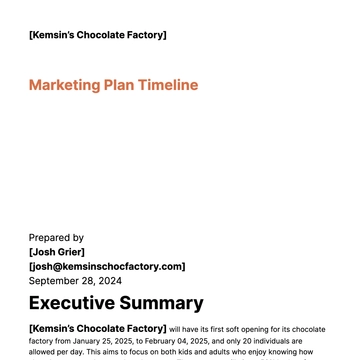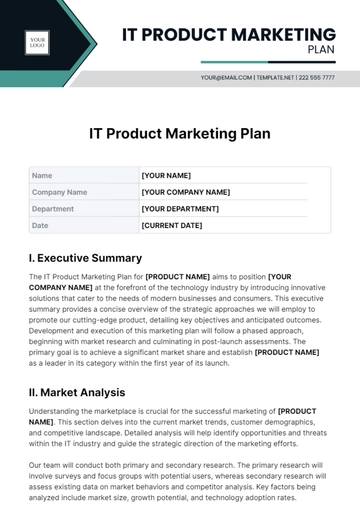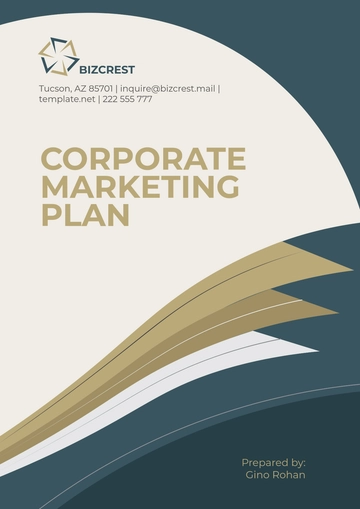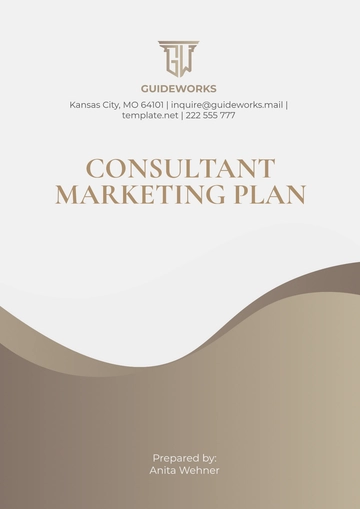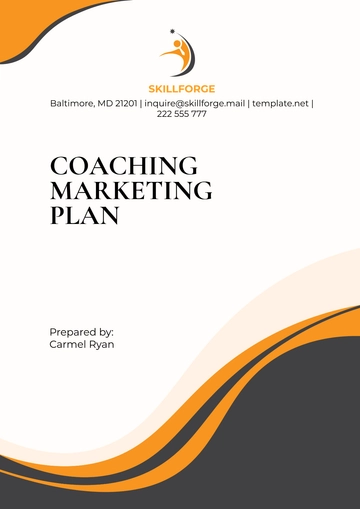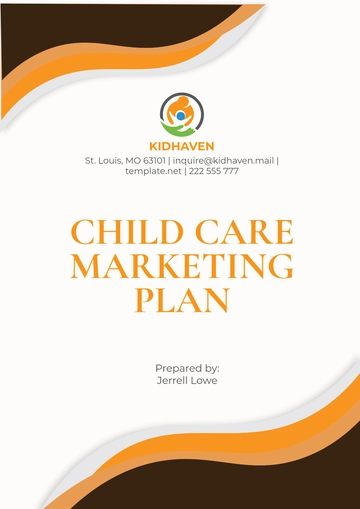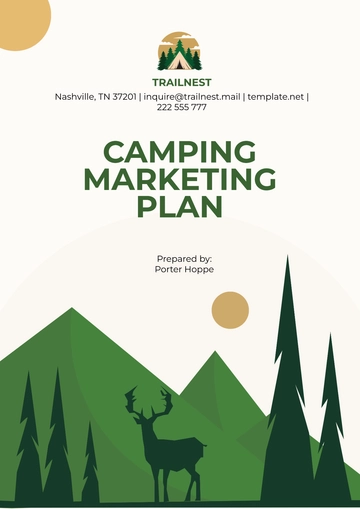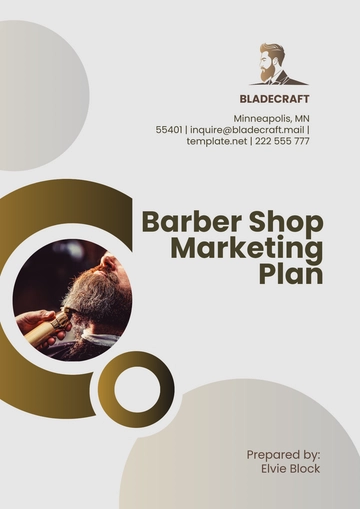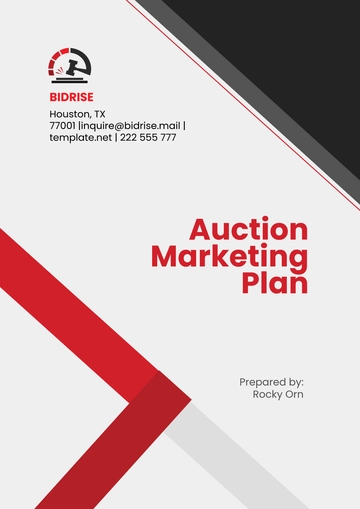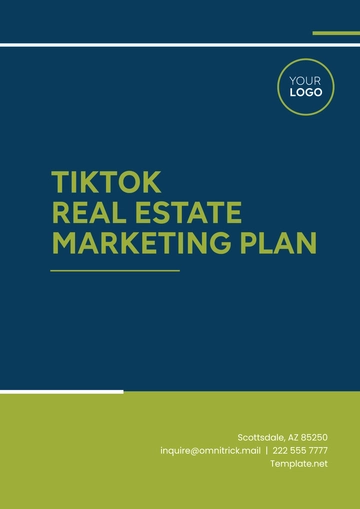Free Bookstore Marketing Plan
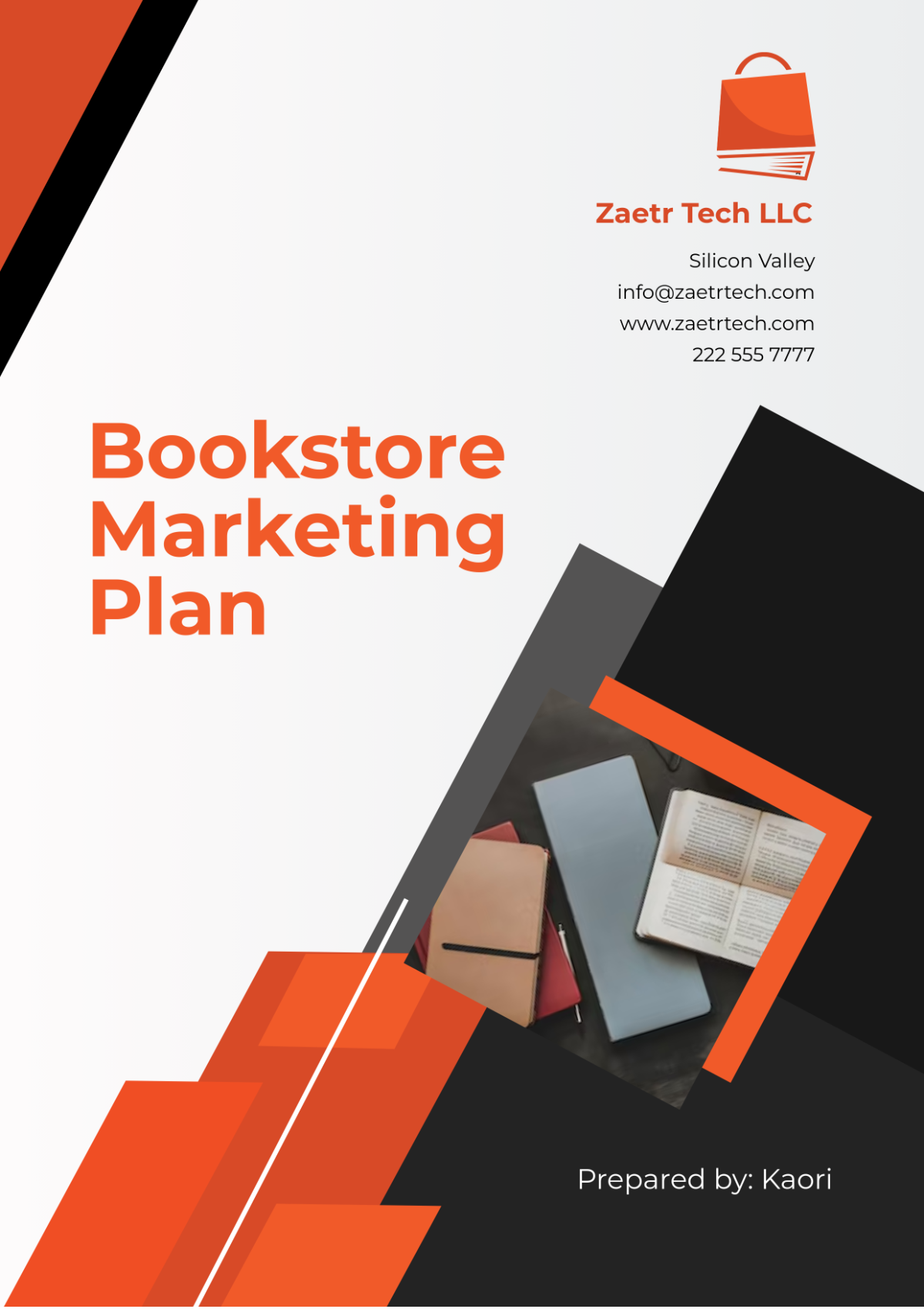
I. Executive Summary
The following document outlines the comprehensive marketing plan for [Your Company Name], a well-established bookstore with a focus on increasing customer engagement, brand awareness, and market share in the years 2050 and beyond. This plan is designed to serve as a strategic roadmap for both physical and digital marketing efforts, aiming to boost sales, retain customers, and expand our audience. By identifying key objectives and implementing targeted strategies, [Your Company Name] intends to solidify its position as the top destination for book lovers in the region and online.
The goal is to achieve projected revenue growth of [$2.5 million] over the next [5] years, based on the activities outlined in this marketing plan. Marketing expenses will be allocated strategically to areas where the return on investment (ROI) is projected to be the highest, ensuring that each dollar spent contributes to the overall objectives of the company.
Through a combination of innovative marketing strategies, engaging events, and exceptional customer service, [Your Company Name] aims to foster a community centered around a love of literature, resulting in a vibrant and sustainable business model.
II. Situation Analysis
A. Market Summary
1. Industry Overview
The global book market has undergone substantial changes over the past few decades. E-books, audiobooks, and digital reading platforms have grown in popularity, yet the demand for physical books remains robust. By 2050, the global book market is expected to reach [$145 billion], with physical books accounting for nearly [65%] of all sales. This indicates a strong market for traditional bookstores, especially those that can adapt to both physical and digital trends.
To capture this evolving market, [Your Company Name] must emphasize not just the sale of books but also the enhancement of the customer experience, focusing on creating memorable interactions that keep readers returning.
2. Target Market
[Your Company Name] primarily targets a diverse demographic, ranging from students and young professionals to older adults who prefer printed books. Our target market can be divided into the following segments:
Primary Market:
Avid Readers: Individuals aged [18-45] with a strong preference for physical books, audiobooks, and educational materials. This segment values the experience of browsing in a bookstore and discovering new titles.
Secondary Market:
Digital Readers: Customers who favor e-books and audiobooks due to their convenience and portability. This group often seeks out sales and promotions on digital platforms.
Educational Institutions: Schools and libraries looking for partnerships for bulk purchasing and educational resources, including textbooks and literary classics.
3. Market Needs
The modern bookstore customer is seeking a convenient, personalized experience, whether shopping in-store or online. Customers increasingly value options for customized recommendations based on their reading history. Additionally, the availability of rare and curated collections adds value, especially for collectors and avid readers. Both physical and digital readers are attracted to engaging content, customized recommendations, and events like author signings or book discussions.
A growing expectation for sustainability in products and operations also drives consumer choices, making it essential for [Your Company Name] to consider eco-friendly practices in its product offerings.
4. Market Trends
Sustainability: There is a growing interest in sustainable products, including environmentally friendly paper and eco-conscious book packaging. Customers appreciate companies that prioritize sustainability, and [Your Company Name] can attract eco-conscious consumers by adopting green practices.
Niche Genres: Increasing demand for niche genres, such as self-published authors and diverse voices in literature, opens new avenues for sales. This trend suggests a need for tailored inventory that reflects a variety of perspectives and experiences.
Audiobooks and Digital Content: The rise in audiobook consumption as people seek content they can enjoy while multitasking shows that [Your Company Name] should not only focus on physical books but also explore partnerships with audiobook platforms and services.
B. SWOT Analysis
1. Strengths
Strong Brand Identity: [Your Company Name] is known for its wide variety of book genres and high-quality customer service. A reputation for knowledgeable staff and a welcoming atmosphere contributes significantly to customer loyalty.
Loyal Customer Base: With over [10,000] regular customers, [Your Company Name] has a loyal community of repeat buyers who value personalized service and a curated selection of titles.
Omnichannel Presence: A seamless integration between the physical store and an online shopping platform enables easy access for all customers. This flexibility ensures that customers can shop according to their preferences, whether online or in-store.
2. Weaknesses
Limited Geographic Reach: While the online store covers a broad audience, the physical store is confined to one geographic area, which may limit brand awareness in untapped markets.
High Overhead Costs: The costs associated with maintaining a physical bookstore, including rent, utilities, and staffing, are significantly higher than an online-only presence. These costs can limit the ability to invest in marketing and product development.
Dependency on Book Sales: Revenue is primarily dependent on book sales, with limited diversification in products and services. To mitigate risk, [Your Company Name] must explore additional revenue streams.
3. Opportunities
Growth of E-Commerce: There is significant potential for expanding online sales with targeted digital marketing strategies. A well-optimized online store can attract customers from different regions and demographics.
Partnerships with Schools and Libraries: By forming partnerships with educational institutions, [Your Company Name] can create steady revenue streams from bulk orders, allowing for the expansion of customer relationships.
Events and Workshops: Hosting more book signings, author talks, and literary workshops can draw in a wider audience, promoting community engagement and increasing foot traffic.
4. Threats
Competition from Online Giants: Companies like Amazon have captured a large portion of the book market by offering low prices and convenience. This competition puts pressure on [Your Company Name] to find unique selling propositions that differentiate its offerings.
Rising E-book Popularity: The rising popularity of digital books and audiobooks may reduce the demand for physical copies, requiring [Your Company Name] to adapt its inventory and marketing strategies accordingly.
Economic Downturns: During economic recessions, customers may reduce discretionary spending, which includes books. Establishing a value proposition and maintaining customer relationships will be crucial during challenging economic times.
III. Marketing Objectives
A. Short-Term Objectives (Year 2050)
Increase Online Sales: Achieve a [20%] increase in online sales within the next [12] months through targeted digital marketing and improved website functionality.
Boost In-Store Foot Traffic: Increase in-store foot traffic by [15%] by the end of 2050 through engaging community events and promotions.
Grow Social Media Following: Achieve a [30%] increase in social media following across all platforms by employing interactive campaigns and engaging content.
Implement Customer Loyalty Program: Launch a customer loyalty program that increases repeat purchase rates by [10%], encouraging customer retention and brand loyalty.
B. Long-Term Objectives (2051-2055)
Expand Customer Base: Grow the customer base by [40%] over the next [5] years through targeted marketing, partnerships, and community engagement.
Diversify Revenue Streams: Introduce additional revenue streams, such as merchandise like literary-themed apparel, stationery, and book accessories, to supplement book sales.
Achieve Targeted Revenue: Reach an annual revenue goal of [$2.5 million] by the year 2055 through strategic marketing and sales initiatives.
Open Additional Physical Stores: Establish two additional physical stores in key urban markets by 2053 to expand the brand’s geographic presence and customer reach.
IV. Marketing Strategy
A. Target Market Strategy
[Your Company Name] will focus on attracting both existing and new customers through tailored marketing efforts that align with their preferences. Understanding the nuances of each customer segment will guide personalized approaches in product offerings and promotions.
1. Customer Personas
The Avid Reader: This persona represents individuals who are deeply passionate about reading and actively seek out both new releases and classic literature. They enjoy browsing bookstores for hidden gems and appreciate personalized recommendations.
The Digital Native: Predominantly younger consumers, this persona prefers digital formats for their convenience. They are likely to engage with audiobooks and e-books, valuing speed and accessibility over physical products.
The Educational Buyer: This persona includes teachers, librarians, and students who require educational materials. They often look for bulk purchasing options and value reliable, cost-effective resources for learning.
B. Product Strategy
The product strategy will center around expanding [Your Company Name]'s offerings while maintaining the quality and variety that existing customers expect. By continually assessing customer preferences, the product mix can be adjusted to reflect market demand.
Expanding the Catalog: Introducing more niche genres, self-published books, and diverse authors to appeal to a wider audience will enhance the store’s reputation as a go-to destination for book discovery.
Merchandise: Offering literary-themed products, such as bookmarks, tote bags, reading lamps, and even bookish apparel, will attract both readers and gift shoppers. These items can be prominently displayed alongside popular titles to encourage impulse purchases.
Subscription Boxes: Launching a monthly subscription box featuring handpicked books and literary items can create excitement and provide customers with unique experiences. Subscribers will receive curated selections based on their interests, fostering customer loyalty.
C. Pricing Strategy
1. Competitive Pricing
Pricing will remain competitive with major online retailers, but [Your Company Name] will differentiate itself by offering exclusive in-store promotions, discounts for loyalty program members, and bundles that provide better value for money.
2. Value Proposition
Emphasizing quality and customer service as part of the value proposition, [Your Company Name] will maintain a pricing strategy that highlights the benefits of shopping locally. Customer education about the importance of supporting local businesses will also be integrated into marketing campaigns.
D. Promotion Strategy
1. Digital Marketing
Search Engine Optimization (SEO): A robust SEO strategy will improve website visibility on search engines, ensuring that [Your Company Name] appears in search results when potential customers look for books or bookstores online.
Pay-Per-Click Advertising (PPC): PPC campaigns will target specific demographics and keywords to drive traffic to the online store, particularly during promotional events.
Content Marketing: Regularly publishing blog posts, author interviews, and book reviews on the website will establish [Your Company Name] as an authority in the literary community and attract organic traffic.
2. Social Media Marketing
Utilizing platforms like Instagram, Facebook, and Twitter, [Your Company Name] will create engaging content to foster community engagement. Campaigns will include:
User-Generated Content: Encouraging customers to share photos and reviews of their book purchases will build community and encourage word-of-mouth marketing.
Interactive Posts: Polls, quizzes, and Q&A sessions about literature will drive engagement and interaction, creating a stronger connection with the audience.
Influencer Collaborations: Partnering with book influencers can increase brand visibility and reach audiences who might not be aware of [Your Company Name].
3. In-Store Promotions
Events: Hosting author signings, book launches, and literary discussions will draw foot traffic to the store and create a community-centered environment.
Seasonal Promotions: Running themed sales during holidays and special occasions can entice customers to visit the store. For instance, offering discounts on romance novels around Valentine’s Day will attract customers looking for gifts.
Loyalty Program Promotions: Highlighting the benefits of the loyalty program through in-store signage and staff recommendations will encourage sign-ups and repeat visits.
E. Distribution Strategy
Omnichannel Distribution: [Your Company Name] will maintain a strong presence in both physical and digital marketplaces. Ensuring seamless integration between in-store inventory and online shopping will enhance the customer experience.
Local Partnerships: Collaborating with local schools, libraries, and community centers for book fairs and educational events can increase visibility and foster goodwill within the community.
V. Marketing Budget
A. Budget Breakdown
Marketing Activity | Budget Allocation ($) | Percentage of Total Budget (%) |
|---|---|---|
Digital Marketing (SEO, PPC) | [100,000] | [25%] |
Social Media Campaigns | [75,000] | [18%] |
In-Store Promotions & Events | [50,000] | [12.5%] |
Loyalty Program Implementation | [25,000] | [6.25%] |
Influencer Collaborations | [30,000] | [7.5%] |
Partnerships with Schools | [40,000] | [10%] |
Print Advertising | [20,000] | [5%] |
Miscellaneous | [30,000] | [7.5%] |
Total | [400,000] | [100%] |
B. Justification of Budget Allocation
Digital Marketing: As online sales continue to grow, investing heavily in digital marketing ensures that [Your Company Name] can compete effectively in the digital landscape. The allocation for SEO and PPC will generate high ROI by driving traffic to the website and increasing visibility.
Social Media Campaigns: Given the increasing importance of social media for brand engagement, a dedicated budget allows for innovative content creation, influencer partnerships, and paid advertisements to reach a broader audience.
In-Store Promotions & Events: Hosting events not only creates buzz but also fosters community engagement. The budget for in-store activities will be allocated to logistics, guest speakers, and marketing materials.
Loyalty Program Implementation: Investing in a loyalty program strengthens customer retention by offering rewards that incentivize repeat purchases. This budget will cover the technology needed to manage the program and promote it to customers.
Influencer Collaborations: Partnering with influencers will help reach target audiences in a more authentic manner, allowing for organic growth in brand visibility. The budget is set to establish fruitful relationships with book-related influencers.
Partnerships with Schools: Forming partnerships with schools will expand customer reach and create opportunities for bulk sales, which will be vital for maintaining steady revenue streams.
Print Advertising: Although digital marketing takes precedence, print advertising remains an essential strategy for reaching local audiences. This budget will cover promotional materials like flyers and local ads.
Miscellaneous: Allocating funds for miscellaneous activities provides flexibility to explore new opportunities or make adjustments to existing campaigns based on market trends.
VI. Implementation Timeline
A. Yearly Marketing Timeline
Marketing Activity | Timeline | Responsibility |
|---|---|---|
Launch of Loyalty Program | Q1 [2050] | Marketing Team |
SEO and PPC Campaign Initiation | Q1 [2050] | Digital Marketing Specialist |
Social Media Campaigns Start | Q1 [2050] | Social Media Manager |
First Author Signing Event | Q2 [2050] | Events Coordinator |
Launch of Subscription Box | Q2 [2050] | Product Development Team |
Partnership with Local Schools | Q2 [2050] | Outreach Coordinator |
Mid-Year Review of Marketing Strategy | Q3 [2050] | Marketing Director |
Seasonal Sales Promotions | Q4 [2050] | Marketing Team |
Year-End Evaluation of Marketing Efforts | Q4 [2050] | Executive Team |
B. Milestones and Key Performance Indicators (KPIs)
To evaluate the success of the marketing plan, the following milestones and KPIs will be monitored:
Milestone | Target | KPI |
|---|---|---|
Increase in Online Sales | [20%] increase by Q4 [2050] | Monthly sales reports |
Boost In-Store Foot Traffic | [15%] increase by Q4 [2050] | Customer count and sales reports |
Growth in Social Media Following | [30%] increase by Q4 [2050] | Social media analytics |
Successful Loyalty Program Launch | [1,000] sign-ups by Q4 [2050] | Sign-up rate and engagement statistics |
Author Event Attendance | [100+] attendees per event | Event attendance records |
VII. Risk Management
A. Identifying Risks
While executing the marketing plan, several risks may arise:
Market Competition: Increased competition from both local bookstores and online giants can affect market share and pricing strategies. If competitors offer lower prices or better services, [Your Company Name] may need to rethink its offerings and adjust pricing to retain customers.
Changing Consumer Preferences: Evolving customer preferences towards digital reading could decrease physical book sales. Monitoring trends in consumer behavior will be crucial to adapting the product mix and promotional strategies effectively.
Economic Factors: Economic downturns may reduce discretionary spending, impacting overall sales. Developing budget-friendly promotions and diversifying the product range will help mitigate the impact of an economic decline.
Supply Chain Disruptions: Issues with book suppliers or logistics could hinder inventory levels and customer satisfaction. Establishing relationships with multiple suppliers and investing in inventory management technology will help prevent disruptions.
B. Mitigation Strategies
To manage these risks effectively, [Your Company Name] will implement the following strategies:
Diversified Offerings: Expanding product offerings to include digital products, merchandise, and unique events can attract different customer segments and reduce dependency on physical book sales. Creating bundled offers or subscription services can also appeal to a broader audience.
Customer Engagement: Actively engaging with customers through surveys and feedback will help anticipate changes in preferences and adapt accordingly. Regular communication via email newsletters and social media updates will keep customers informed and engaged.
Economic Flexibility: Keeping operational costs flexible will allow the company to adjust prices and offerings based on economic conditions, ensuring continued customer access to products. Implementing sales during economically challenging periods can also boost customer loyalty.
Supplier Relationships: Building strong relationships with multiple suppliers will help ensure a reliable supply chain and minimize the impact of disruptions. Exploring partnerships with local authors for exclusive titles can also provide a unique inventory that differentiates [Your Company Name].
VIII. Conclusion
The marketing plan for [Your Company Name] aims to strengthen the brand's position in the competitive landscape of bookstores, both online and offline. By targeting specific customer segments, leveraging digital marketing strategies, and implementing engaging community events, [Your Company Name] is poised for growth and enhanced brand loyalty.
With a comprehensive budget allocation and a clear timeline for implementation, the business will continuously evaluate its performance against established KPIs to ensure that objectives are met. The outlined risk management strategies will help navigate potential challenges while allowing [Your Company Name] to remain adaptable and resilient in a rapidly changing market.
This marketing plan serves not only as a roadmap for future success but also as a commitment to fostering a vibrant literary community, connecting readers with the stories they love, and enriching the cultural fabric of our society. By 2055, [Your Company Name] envisions itself as a leading hub for literature, creativity, and connection, dedicated to the joy of reading and the importance of local businesses in the global market.
- 100% Customizable, free editor
- Access 1 Million+ Templates, photo’s & graphics
- Download or share as a template
- Click and replace photos, graphics, text, backgrounds
- Resize, crop, AI write & more
- Access advanced editor
Attract more customers with the Bookstore Marketing Plan Template from Template.net. This editable and customizable template provides a structured approach to developing marketing strategies, identifying target demographics, and tracking performance metrics. Personalize it using our Ai Editor Tool to create a plan that resonates with your bookstore's brand and audience.

